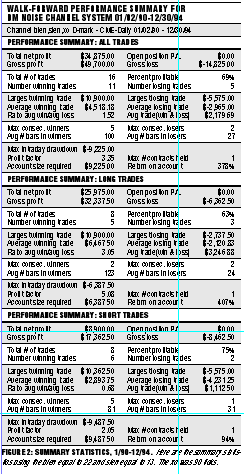SYSTEM DESIGN
by Dennis Meyers, Ph.D.
Interested in a trend-following method for currency markets? Currency markets generally exhibit the strongest tendency to trend, a key feature for trend-followers. Here, then, is a method that is both simple and effective to take advantage of that. Presented here are the rules and steps to develop a trend-following method for currencies.
The German mark (abbreviated DM, for Deutschemark) is a major currency traded worldwide by corporations, institutions, banks, commodity funds and futures traders. It is traded 24 hours per day, and most of the world's largest banks make a two-sided market in it and its associated derivatives.
Small traders, however, are constrained to trade the DM futures on the Chicago Mercantile Exchange (CME). German mark futures are traded from 7:20 am to 2:00 pm on the CME and from 2:30 pm to 7:05 am on the CME Globex system. While the CME DM futures trading volume is small when compared with total worldwide bank and institutional trading volume, arbitrage keeps the futures prices in line with the bigger markets.
DATA DISCUSSION
The DM futures contract on the CME trades in the quarterly cycles of March, June, September and December. As of this writing, the current active DM futures contract is the German mark March 1998. This is the CME futures contract that expires on the second business day before the third Wednesday of March 1998. The DM June 1998 will become the active contract one week before the March 1998 expiration day.
Each DM futures contract is worth the dollar value of 125,000 marks. On January 2, 1998, the DM March 1998 closed at 0.5567 dollars per mark, making one DM contract worth $69,587.50 (0.5567 x 125,000). The DM future trades in units of $0.0001 per DM. Thus, a move of one tick (0.0001) is worth $12.50 per contract (0.0001 ($/DM) x 125,000 (DM) = $12.50). The Wall Street Journal quotes the DM futures in this fashion. Some data vendors move the decimal point two places to the right.
The DM futures started trading in 1975, but for our purposes, we will limit our study to the price history from January 1, 1990, to today. In addition, we will use a DM futures continuous contract, since DM futures contracts expire each quarter. A continuous contract is constructed by switching to the active contract on the rollover day and back-adjusting the difference in prices between the new contract and old contract, thus creating a smooth continuous contract. The performance results from systems using continuous contracts cannot duplicate actual results from trading real contracts exactly because of the costs of actually having to exit one contract at one price and enter the new contract at a different price. Despite the rollover costs, the results are still indicative of the worth of the trading system.
Whether or not a system is secret, the key issue for anyone considering trading a system is how well it has performed on data the system has not been optimized on -- that is, out-of-sample data.
Dennis Meyers has a doctorate in applied mathematics in engineering. He is a member of the Chicago Board Options Exchange (CBOE), a private trader, and president of Meyers Analytics. His firm specializes in consulting for financial institutions and developing publicly available analytical software for traders. He can be reached at 312 280-1687, via his Web site at https://www.MeyersAnalytics.com or via E-mail at meyersx@MeyersAnalytics.com.
